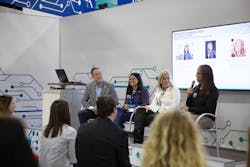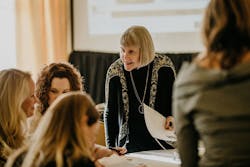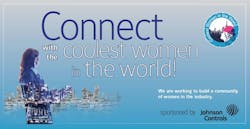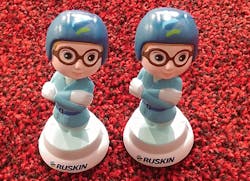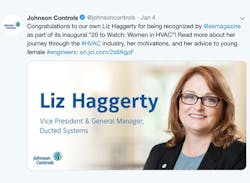It’s no surprise that even as the numbers of women choosing a career in the traditionally male-dominated heating, ventilating and air-conditioning industry are increasing, they still make up a small percentage of workers. Women comprise less than 10 percent of the entire construction workforce, 7 percent in engineering and 2 percent as HVAC technicians.
The dearth of female role models in the industry led to the start-up of several organizations tasked with the mission of lifting women in HVAC positions, networking and recruiting more women to choose careers in the HVAC field.
One such group was started by women at manufacturer Johnson Controls (JCI), partly to help rectify the lack of women in HVAC fields and the skilled workforce crisis plaguing the entire construction industry — the Coolest Women in the World.
“It’s estimated that less than 2 percent of the approximately 60,000 members of the American Society of Heating, Refrigerating and Air-Conditioning Engineers (ASHRAE) are women,” notes Renee Joseph, JCI'S global vice president of customer and sales enablement. “With 50 percent of that population retiring in the next three to five years, half of the remaining talent pool will be women. Therefore, it’s imperative for us to continue to attract more women to this industry as buyers and influencers are becoming more diverse and prefer to work with diverse companies.”
Hiring women is also a good business practice, she adds, as research indicated that companies with diverse teams are more profitable.
“Bringing women into our organization provides diversity in both thought and experience, which is valuable to the outcomes we are looking to achieve,” Joseph says. “This ultimately translates into higher profitability for the products and solutions we provide to our customers.”
The mission of the Coolest Women in the World is to help bring focus to the diversity advantage and growth potential, help advance women in HVAC and show women outside the industry that rewarding and lucrative careers are available to them within the HVAC industry.
“We want to bring broader awareness of the industry to women in general and establish relationships with women currently working in HVACR,” Joseph explains. “This allows us to grow, foster and engage with other companies and associations who share a common mission and, in turn, allow us to scale our reach and efforts.”
The Coolest Women in the World has a small core team with the involvement of about 50 people once the annual AHR Expo gets close. The group holds panel discussions and hosts networking events throughout the year. In addition, Johnson Controls holds a biannual event where it invites women from across the country to visit and tour its facilities while providing educational workshops and networking opportunities.
The ‘Hidden’ Industry
Joseph acknowledges that the biggest challenge to recruiting women into HVAC is awareness of what it is.
“If you think about it, we are pretty much a ‘hidden’ industry — behind walls, in the basement or on a roof,” she says. “Most people are completely unaware of the HVACR industry unless they have a family member or acquaintance involved in it. But when we take the time to explain how impactful this industry is to the countless number of people we impact around the globe, it helps us better inform women and become more appealing.”
To better inform women about the career opportunities available in HVAC, the industry needs to frame the message so that it speaks to what women are concerned about, Joseph says.
“As one of the largest energy consumers in the world, the HVACR industry is committed to creating more sustainable, environmentally friendly solutions,” she explains. “This value statement can be very compelling to a female audience. We know from research that women are typically looking for a company and position where they can make a difference. We need to frame our message in this context to attract more female employees.”
Once women enter the industry, the challenge is to make them feel not only comfortable in a male-dominated industry but also confident in their ability to contribute and thrive in it.
“Women need to be willing to take a bold position at times to be heard and understood,” Joseph explains. “An unconscious bias often exists, so taking time to understand this and working through methods that fit within their personal style is very important to overcoming these challenges.”
Networking opportunities are the primary benefit of joining the Coolest Women in the World, especially for recruiting and mentoring purposes. “The power of people interested in attracting more women into the industry is compelling,” she says. “We find connections made during these social events can lead to more women joining the industry by providing awareness of job openings or finding a mentoring partner.”
That includes working with like-minded organizations. Johnson Controls is a platinum sponsor for the nonprofit Women in HVACR. It works closely with the organization on its programs including education, mentoring and networking. Joseph sits on the board, serving this year as chairperson for the affiliations and partnership committee.
‘Be Adventurous’
The Coolest Women in the World is open to anyone who wants to recruit and retain women in the HVACR industry. Interested persons can contact Johnson Controls via www.johnsoncontrols.com.
For women starting their careers in HVAC, Joseph has some advice. “Be adventurous. Seek out people from all types of job categories. Ask for 30 minutes of their time to talk about their role and contribution to the industry. It’s amazing how much value women gain and how many relationships they establish.”
She also encourages women to seek out one or two people as mentors. “Most people are willing to help; they just need to be asked,” she explains. “I believe mentoring helps from both an educational as well as a social standpoint since it allows women to make additional connections in the workplace.
“Finally, I would secure a sponsor. This is different than a mentor relationship. A sponsor is someone who has experience working with you and knows the contribution you can make. They become your advocate and look for ways to help you advance your career.”
About the Author

Kelly L. Faloon
Contributing Writer/Editor
Faloon spent 3 1/2 years at Supply House Times before joining the Plumbing & Mechanical staff in 2001. Previously, she spent nearly 10 years at CCH/Wolters Kluwer, a publishing firm specializing in business and tax law, where she wore many hats — proofreader, writer/editor for a daily tax publication, and Internal Revenue Code editor.
A native of Michigan’s northern Lower Peninsula, Faloon is a journalism graduate of Michigan State University. You can reach her at [email protected].

